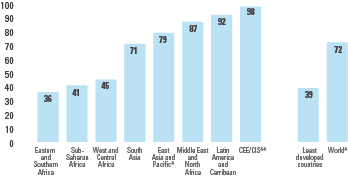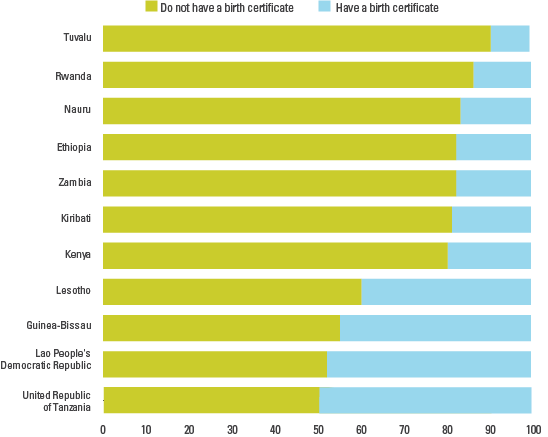A name and nationality is every child’s right, enshrined in the Convention on the Rights of the Child and other international treaties. Yet the births of nearly 230 million children under the age of five worldwide (around one in three) have never been recorded. This lack of formal recognition by the State usually means that a child is unable to obtain a birth certificate. As a result, he or she may be denied health care or education. Later in life, the lack of official identification documents can mean that a child may enter into marriage or the labour market, or be conscripted into the armed forces, before the legal age. In adulthood, birth certificates may be required to obtain social assistance or a job in the formal sector, to buy or prove the right to inherit property, to vote and to obtain a passport. Registering children at birth is the first step in securing their recognition before the law, safeguarding their rights, and ensuring that any violation of these rights does not go unnoticed.

Every Child's Birth Right: Inequities and trends in birth registration
This publication presents the latest available data on the extent of unregistered children and assesses progress to date in increasing birth registration rates worldwide.
DATA SOURCES
The number of children who have acquired their right to a legal identity is based on official registration figures, censuses, vital statistics and household surveys. Civil registration systems that are functioning effectively compile vital statistics that are used to compare the estimated total number of births in a country with the absolute number of registered births during a given period. However, the systematic recording of births in most countries remains a serious challenge. In the absence of reliable administrative data, household surveys have become a key source of data to monitor levels and trends in birth registration. In most low- and middle-income countries, such surveys represent the sole source of this information.
The two main household survey programmes that collect data on birth registration are the Demographic and Health Surveys (DHS) and the Multiple Indicator Cluster Surveys (MICS).
To assess the levels of birth registration, the MICS questionnaire asks all mothers (or primary caregivers) of children under age 5 to respond to questions regarding the possession of a birth certificate or registration with civil authorities and knowledge of how to register a child. Data on birth registration have been collected through MICS since 1999 in almost 130 surveys conducted in about 50 low- and middle-income countries.
The standard household questionnaire used in DHS includes a question on whether all children under age 5 are registered. In previous rounds of DHS, questions on birth registration were asked as part of a section on reproductive health in the individual questionnaire addressed to girls and women of reproductive age. Information on whether births had been registered was recorded for all of a woman’s deliveries in the five years preceding the survey, regardless of whether the child(ren) survived. The first DHS with data on birth registration was conducted in 1993; since that time, data on the issue have been collected in more than 90 DHS around the world.
MAIN INDICATORS
The standard indicator used in DHS and MICS to report on birth registration refers to the percentage of children under age 5 (0 to 59 months) with a birth certificate or whose birth was reported as registered with civil authorities at the time of survey. Data derived from vital registration systems normally refer to the proportion of live births that were registered within a year or the legal time frame for registration applicable in the country.
INTERPRETING THE DATA
Birth registration prevalence rates are highly sensitive to the way in which questions are formulated. This is especially true of questions regarding the civil authorities in charge of recording births. Respondents may not always be clear on who these authorities are and may misinterpret notifying a church or village chief of a birth as formal registration. Household surveys generally customize questionnaires by naming the specific national authority responsible for registration. But even then, confusion about the birth registration process may result. Similarly, questions regarding the possession of a birth certificate may also be the source of erroneous data, since respondents may confuse a birth certificate with a health card or other document.
The availability of data on birth registration is highly uneven across countries. The latest source of comparable data in some cases dates back to 2000; in other cases, it is as recent as 2012. It is also crucial to remember that data indicate birth registration status at the time of data collection and do not necessarily reflect the current situation.
Several important factors should be considered when examining trends in birth registration:
- Variations in the number of years between consecutive surveys or other data sources. These can range from 1 to more than 20, depending on the country.
- The number of data points available for each country. Patterns of change are more evident when several data sources are available for a country.
- The magnitude of change. Change can be gauged by looking either at the absolute difference (change in percentage points) between estimates or by looking at the percentage change between estimates. Conclusions should be drawn on the basis of both measures.
- Survey design and implementation. This could include, for example, changes in sampling frames, questionnaire content and structure, and language used to refer to civil authorities.
MICS MODULE ON BIRTH REGISTRATION
MICS surveys have a standardized module on birth registration.




_267.png)
